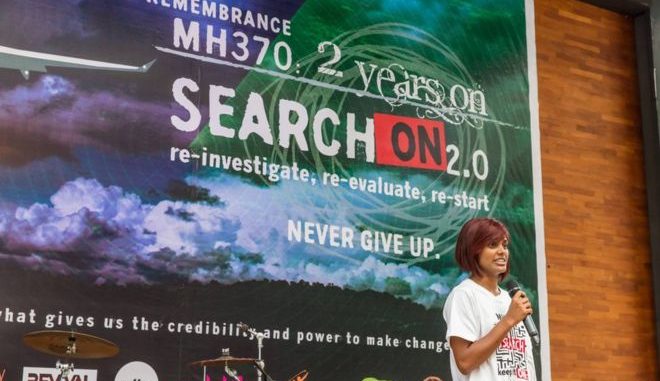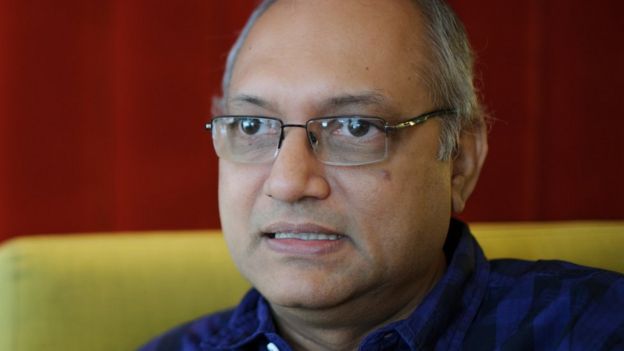
[BBC] Families of passengers from missing Malaysia Airlines Flight MH370 have told the BBC that Malaysian authorities seem to be ignoring possible new evidence.
Two trips to Madagascar to pick up what might be debris from the plane have been cancelled at the last minute, according to the man that found them.
The potential clues have been left untouched for weeks, with no prospect of them being gathered and examined.
“Credible evidence is turning up, why are they not investigating it?” Grace Subathirai Nathan told the BBC.
Her mother, Anne Daisy, was on MH370 when it disappeared in March 2014.
“From day one we’ve had the notion they want an end to it, to sweep it under the rug. How can potential evidence be unattended for a month? It’s becoming a farce.”
American Blaine Gibson sold the family home to fund his own search for parts of MH370. Having found one piece in Mozambique that investigators say is “almost certainly” from the plane, he travelled to Madagascar where he uncovered more potential evidence.
Blaine says a Malaysian investigator was initially due to fly to Madagascar to retrieve the debris on 16 June. That was then changed to 21 June. A press conference was lined up, then the trip was cancelled at the last minute.
Blaine even offered to take the finds to Malaysia himself but says his offer was turned down.

Grace is not the only frustrated MH370 family member.
“It’s been nearly a month, but the Malaysian response has been bordering on indifferent”, K S Narendran, known as Naren, told the BBC.
“The point is, these are all pieces of a puzzle, that pieced together might tell us a story.” Naren lost his wife Chandrika on the plane.
The official reason is that they don’t have enough money for the trip, but Naren suspects something else.
“I wonder if it’s just a way to bring it to a quiet close.”
The Australian Transport Safety Board told the BBC: “Australia is leading the underwater search for MH370 but it is Malaysia, as the investigating body, that retains authority for coordinating the examination of debris.”
The BBC contacted both the Malaysian authorities and ICAO, but was unable to get a response.
An investigator’s view
The few pieces of MH370 that have emerged so far have told us nothing about why the plane crashed. So why is it so important to collect more?
“Their examination can reveal information about how the aircraft hit. For example, are all the pieces from the left or right side of the aircraft?” said Anne Evans, an accident investigator with the highly respected British Air Accidents Investigation Branch for 23 years.
She told the BBC that debris could answer other questions too.
“Was the aircraft intact when it hit the water, so do we have pieces from the entire fuselage, front and rear? Although the information gleaned from these items may be extremely limited given their small number, the documentation and analysis of all pieces can still yield some clues”.
Families becoming ‘an irritation’
It’s important to note than these Madagascan finds may have nothing to do with MH370, although various experts I’ve spoken to suggest there is a good chance at least some are from the plane.
“I don’t understand why they won’t even take a look at it,” Naren said. “I understand members of my family won’t come back, but it doesn’t take away my need to know. I wonder if the families have become an afterthought or an irritation.”
Grace, who runs a support group for the families, says they have tried to raise the issue elsewhere.
“We have written to the ICAO [International Civil Aviation Organization – the UN body in charge of aviation] but they don’t write back. The Malaysians shun us.”
“We have absolutely no communication with investigators. We still don’t know what they found from analysis on the flaperon [the first confirmed piece of MH370 debris to be found].”
They are also upset that the Malaysian government recently said that the possible personal effects found in Madagascar were nothing to do with the plane. “How do they know” Grace said, “without examining them?”
Where confirmed or suspected MH370 debris was found
1. A section of wing called a flaperon, found on Reunion Island in July 2015 -confirmed as debris in September 2015
2. Horizontal stabilizer from tail section, found between Mozambique and Madagascar in December 2015
3. Stabilizer panel with “No Step” stencil, found in Mozambique in February 2016
4. Engine cowling bearing Rolls-Royce logo, found in March 2016 in Mossel Bay, South Africa
5. Fragment of interior door panel found in Rodrigues Island, Mauritius in March 2016
6. Fragments including what appears to be a seat frame, a coat hook and other panels found on Nosy Boraha island in north-east Madagascar.
Grace and Naren both support the expensive, complex and dangerous sea search now combing the ocean floor six days sail from Australia. But that could be wound up in a matter of weeks or months.
If no new clues come to light, the Malaysian and Australian governments have said they will call it off.
That is why the families want the search extended, to the beaches on the other side of the Indian Ocean, where more than two years later, the only solid clues to this whole mystery are washing up.
Grace says not knowing what happened is torture.
“My biggest fear is that the whole thing will be forgotten. We’ve all gotten’ worse in our own way, we need to be able to understand something before we can accept it”.
Naren says if you don’t solve the mystery, you can’t stop it happening again:
